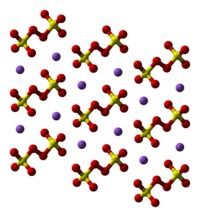Sodium persulfate
 |
|
 |
|
 |
|
| Names | |
|---|---|
| Other names
Sodium peroxodisulfate
Sodium peroxodisulphate Sodium peroxydisulfate Sodium peroxydisulphate |
|
| Identifiers | |
|
7775-27-1 |
|
| 3D model (Jmol) | Interactive image |
| ChEMBL |
ChEMBL502764 |
| ChemSpider |
56406 |
| ECHA InfoCard | 100.028.993 |
| EC Number | 231-892-1 |
| PubChem | 62655 |
| RTECS number | SE0525000 |
| UN number | 1505 |
|
|
|
|
| Properties | |
| Na2S2O8 | |
| Molar mass | 238.10 g/mol |
| Appearance | white powder |
| Density | 2.59 g/cm3 (Loose bulk density: 1.12 g/cm3) |
| Melting point | 180 °C (356 °F; 453 K) decomposes |
| 55.6 g/100 ml (20 °C) | |
| Hazards | |
| Safety data sheet | ICSC 1136 |
| R-phrases | R8 R20 R22 R36 R37 R38 |
| S-phrases | S17 S26 S36 |
| NFPA 704 | |
| Flash point | Non-flammable |
| Related compounds | |
|
Other anions
|
Sodium dithionite Sodium sulfite Sodium sulfate |
|
Other cations
|
Potassium persulfate |
|
Except where otherwise noted, data are given for materials in their standard state (at 25 °C [77 °F], 100 kPa).
|
|
|
|
|
| Infobox references | |
Sodium persulfate is the inorganic compound with the formula Na2S2O8. It is the sodium salt of persulfate (also called peroxydisulfate), an oxidizer. It is a white solid that dissolves in water. It is almost non-hygroscopic and has good shelf-life.
The salt is prepared by the electrolytic oxidation of sodium hydrogen sulfate:
Oxidation is conducted at a platinum anode. In this way about 165,000 tons were produced in 2005.
The standard redox potential of sodium persulfate into hydrogen sulfate is 2.1 V, which is higher than that of hydrogen peroxide (1.8 V) but lower than ozone (2.2 V). The sulfate radical formed in situ has a standard electrode potential of 2.7 V.
It is mainly used as a radical initiator for emulsion polymerization reactions for styrene based polymers such as Acrylonitrile butadiene styrene. Also applicable for accelerated curing of low formaldehyde adhesives.
It is a bleach, both standalone (particularly in hair cosmetics) and as a detergent component. It is a replacement for ammonium persulfate in etching mixtures for zinc and printed circuit boards, and is used for pickling of copper and some other metals.
It is also used as a soil conditioner and soil remediation and in manufacture of dyestuffs, modification of starch, bleach activator, desizing agent for oxidative desizing, etc.
...
Wikipedia

